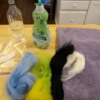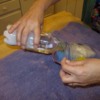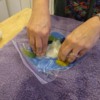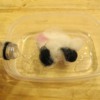 Here is a complete set of lessons for…
Here is a complete set of lessons for…
Psalm 23: A Shepherds Psalm
Summary of all workshops in this Rotation:
- Art: Children will create felted pictures/sheep from sheep's wool.
- Games & Bible Skills: Children will play several games about following and listening to God.
- Computers: Children in Grades 2-5, & 6-7 will use Crossword Studio Bible Edition software to create crossword puzzles to explore the meaning of the words in the psalm . Children in Grades K-1 will use Kid Pix to illustrate the psalm.
- Drama: Children will visit 8 stations to experience the different verses of the psalm. (For example, verse 2 - lie down on a large piece of green felt. Discuss how God helps you rest.)
- Music & Movement: Children will use Sign Language to learn to sign the psalm.
- Video: Children will view The Story of David (Children’s Heroes of the Bible, Gateway Films-Vision). They will learn about King David's role in writing many of the psalms. (Video-running time 23 minutes)
Scripture References:
Psalm 23 (Using the NIV Adventure Bible)
The Picture Bible: "The Chosen One" pages 278-280 (for younger students)
Memory Verse:
Psalm 23 (Encourage the children to learn as much as possible of this psalm)
He makes me lie down in green pastures.
He leads me beside the still waters.
He restores my soul.
He leads me in right paths for his name’s sake.
Even though I walk through the darkest valley, I fear no evil;
For you are with me. Your rod and your staff, they comfort me.
You prepare a table before me in the presence of my enemies.
You anoint my head with oil
My cup overflows.
Surely goodness and mercy will follow me all the days of my life,
And I will dwell in the house of the Lord forever.
Note: This is not the translation found in our Bibles, rather it is NRSV with a bit of New King James – a version more familiar to most people.
Theme:
- God loves us and cares for us like a shepherd cares for his sheep.
Rotation Objectives:
- Children will define psalm: a song or poem in the Bible.
- Children will locate Psalm 23 in the Old Testament of the Bible.
- Children will explain the meaning of the Psalm in their own words.
- Children will define Psalms as a book of poetry (older grades).
- Children will identify David as the author of many of the Psalms.
- Children will describe some of the responsibilities of a shepherd.
- Children will describe how God is like a shepherd to us and how we are like sheep.
- Children will recognize that God is with us even through scary or sad times.
- Children will identify Jesus as the Good Shepherd.
- Children will memorize Psalm 23.
Bible Notes in the NIV Adventure Bible:
- Words to Treasure: page 618
- Life in Bible Times: What God is Like, page 618
- Let’s Live It: God is My Shepherd, page 619
Resources for Workshops:
- The Lord is my Shepherd, Illustrated by Anne Wilson, Eerdman's Books for Young Readers, 2003
- The Lord is my Shepherd: Psalm 23 for Children, Christopher L. Webber, Morehouse Publishing, 2004
- The Lord is my Shepherd, Little Shepherd Books, Scholastic, 2006.
- A poster of Psalm 23 for each room.
Rotation Music CDs
- “Books of the Old Testament,” Books of the Bible, Custom CD, Troy and Genie Nilsson.
- “Books of the New Testament,” Books of the Bible, Custom CD, Troy and Genie Nilsson.
- Psalm 23 - Jeff Majors, Sacred Major 7th, Music One, 2007.
- He Will Carry Me – Mark Schultz, He Will Carry Me, Word Entertainment, 2003.
- "I'll Lead you Home," Michael W. Smith, 1995.
- "Do not Fear," Seeds of Courage, Seeds Family Worship, 2007.
- "I am the Good Shepherd," Verse 2 Verse, Top Kidz,
- "The Lord is My Shepherd," Hidden in my Heart, 2009.
- "Draw Me Close To You," the Katinas, Lifestyle: A Worship Experience, 2002.
Background Information for Teachers
The book of Psalms is an Old Testament book of Poetry, found in about the middle of the Bible. The word Psalm actually comes from the Hebrew word mizmor, a term meaning a “sacred song, sung to musical accompaniment.” This was translated psalmos in the Greek. In Alexander’s Old Testament translation, the book of Psalms was called Psalterion, from which we get the word Psalter. In the Hebrew Bible the book is called sephir tehillim, meaning Book of Praises. This is a good description of the Psalms, for much of the book consists of praises to God.
A glimpse into emotions
The Psalms give us a glimpse into Israelite history – but not simply a record of events that occurred. Rather the Psalms provide us knowledge of the emotion and spiritual aspect of the Israelites. The Psalms provide a witness to the “timeless and universal nature of man.” The Psalms capture the emotions, personal feelings, attitudes and thoughts of the average person. They show us that these very same experiences of old are also ours today. For no matter what our experiences are, we can find them somewhere recorded in the book of Psalms. The overarching theme of the Psalms is a theology of relational: God in relationship with us! The Psalms model intimacy with God.
A guide for prayer
The Psalms are a guidebook for prayer. They describe the Israelites’ struggle with situations, emotions and how they brought these feelings to God. They teach us the right way to handle our emotions as we work through our troubles. Emotions are not bad; they are a part of being human. By coming before God and honestly sharing our emotions, we learn to handle them. We can vent in a safe environment. After all, God is big enough to handle all of our emotions – good and bad! We cannot hide our feelings from God anyway. By bringing them to God, we develop a more personal and intimate relationship. God is not a distant God who winds us up and sets us free while watching us from afar. God desires nothing more than an intimate, close and daily walk with us! We see in the Psalms that God accepts us as we are, in fact God treasures us as His special creation. The Psalms teach us that God is deeply personal and relational. The Christian faith is not just an intellectual exercise. It is about a relationship that engages the heart as well as the mind!
Authorship; dates written
The Psalms were written over a long period of time, possibly from 1400-400 B.C. Some of the Psalms may be among the oldest of Bible literature. Psalm 90 is attributed to Moses! Of 150 psalms, 73 are believed to be written by David. The different psalms are organized into five books based on the time they were officially added to the worship collection of the Hebrews.
- Psalms 1-41: These are believed to have been compiled before David’s death.
- Psalms 42-72: These were probably added during the reign of Solomon.
- Psalms 73-89: Added during the period of the Exile.
- Psalms 90-106: Also added during the period of the Exile.
- Psalms 107-150: Added during the time of Ezra, mostly liturgical psalms
Understanding psalms
Psalms are classified as Old Testament poetry. To understand the Psalms it is necessary to understand the concept of parallelism. There are several types of parallelism reflected in the psalms.
- Synonymous Parallelism – The same thought is repeated using different words. Hebrew poetry does not repeat sounds or use rhyming words as Western poetry does. Rather, thoughts or ideas are repeated using vivid imagery, metaphors or similes. This allows Hebrew poetry to be effectively translated into any language!
- Antithetical Parallelism – One thought is followed by a contrasting thought.
- Synthetic Parallelism – Adding thoughts to further develop or explain the original thought.
The Psalms also reflect different themes:
- Praise Psalms focus on God and describing God’s nature.
- Historical Psalms explain how God deals with God’s people throughout history.
- Relational Psalms describe the personal relationship between God and the believer.
- Imprecatory/cursing Psalms call on God to judge and overthrow the wicked.
- Penitential Psalms express repentance and sorrow over personal failings and sin.
- Messianic Psalms refer to Christ, the One who is to come through King David’s line.
- Liturgical Psalms are used in worship for specific occasions or annual festivals.
Psalm 23 - a Psalm of David
Psalm 23 is probably the most well-known and loved psalm in the Bible. Many of the psalms were written by or attributed to David. Psalm 23 is one of David’s psalms. David was a shepherd before being chosen by God to become Israel’s king. His many years spent alone with sheep must have prepared him for the role he was to play in Israel’s history. Certainly the quiet of long days apart from human conversation led him to a deep and abiding faith in God. Through David’s experiences as a shepherd, he found key correlations to God’s relationship with us.
Sheep are mentioned over 500 times in the Bible. A shepherd cares for the sheep, providing safety, nourishment and love to his flock. In this Psalm David describes God as the shepherd and we humans as His sheep. The prophets and New Testament writers continued with this imagery. Jesus himself, referred to himself as the Good Shepherd who lay down his life for his sheep. Sheep imagery is found throughout the Bible, perhaps because sheep were such a common and well-understood part of life at that time. Sheep were valuable assets and a strong economic resource. To be called sheep was affirming our worth and importance to God.
Because David was a shepherd, it can be helpful to examine this Psalm from the perspective of a real shepherd. Phillip Keller, in his book, A Shepherd Looks At Psalm 23, illuminates the text from the viewpoint of one who has spent his life caring for sheep.
The Lord is my shepherd...
Sheep and people share many characteristics. Both can be stubborn, fearful and prone to following the crowd. Who is our shepherd? David clearly states that the Lord is our shepherd! Do we claim him as our shepherd? Do we truly belong to the shepherd? Are we content to be led by the Shepherd, rather than heading out on our own?
Shepherds keep track of the sheep in their flock by branding them with a notch on their ears. This makes the sheep easily recognizable to the shepherd and to others if the sheep should wander off. Are we easily recognized as belonging to our Shepherd? Do others recognize us as Christian? What notches do we have in our lives that clearly show we belong to the Shepherd?
I shall not want….
The meaning of the word want here is that we have what we need, we are not lacking, we are satisfied. The underlying thought is that when we claim the Lord as our shepherd, we are content. We do not crave or desire more. This does not mean that God promises us wealth and prosperity. In fact, Jesus promised the opposite to his believers. There is a cost to following Jesus. But contentment means our greed lessens and that we no longer have a constant desire for more material things.
He makes me lie down in green pastures….
It is hard to make sheep lie down. According to Keller, four things are necessary for sheep to relax enough to lie down. They must be:
- Free of fear.
- Free of friction and tension from other sheep
- Free of pests, parasites and aggravation
- Free of hunger.
Only the shepherd can provide freedom from these situations. Sheep are by nature fearful and vulnerable animals. One startled sheep can cause a whole flock to blindly bolt without ever understanding what the threat is! The presence of the shepherd is calming to the sheep.
For Christians, the presence of the Shepherd is calming as well. Knowing the shepherd is nearby helps us deal with our anxiety, calms us down during panicky times and helps us cope with the fear of the unknown and the unexpected.
Like many animals, sheep have a “pecking order.” Dominant sheep will aggravate the more passive animals, keeping the flock in continual state of jealousy and conflict. When the shepherd is present, this behavior ceases. We as humans struggle with the desire to be “Top Dog”(?sheep?), for status and to keep up with our neighbors. When we are in the presence of Christ, our selfishness, snobbery and rivalry will stop.
Insects and parasites torture sheep, especially during certain seasons of the year. The shepherd applies insect repellants, provides shelter and shade to protect the sheep from these irritations.
The Holy Spirit’s presence provides us with contentment and calm during times of aggravation.
Sheep tend to thrive in hot, dry climates because there are less parasites and health hazards. Unfortunately, lush green pastures don’t thrive in those climates! Preparing a pasture for sheep requires diligence and care on the part of the shepherd. Rocks are removed, soil must be prepared and seed sown.
God provides green pastures for us by removing the stony rocks of unbelief in our lives, breaking up our hard hearts and sowing his Word like seed in the soil of our hearts.
He leads me beside still waters….
All living things require water. Thirst is the body’s natural response to lack of water. If clean water is unavailable, sheep will drink from any mud hole or ravine. Cool, clear water is what sheep need. They are afraid of fast-moving water. Sheep scare easily so shepherds search for calm, still waters where the sheep can be refreshed. We too, are thirsty for God’s Word – and we are never truly fulfilled until we recognize that. Sheep can get all the water they need from grazing on dew-soaked grass in the early mornings. Wise shepherds make sure the flock is out early. Then once the hot sun comes up, the sheep can rest quietly in the shade content, well-fed and well-watered.
Many strong Christians recognize the wisdom gleaned from the shepherd. Spending time in God’s word in the early morning is perhaps the best way to start the day.
He restores my soul…
Sheep have the unfortunate characteristic of getting stuck on their backs or being “cast down” or “cast.” A resting sheep might roll over a bit too far on its side and end up stuck on its back with legs flailing. They depend on the shepherd to come and set them on their feet again. A “cast” sheep is easy prey for predators, so a shepherd is always on the lookout, counting all his sheep to make sure they are all safe.
Once found, the shepherd gently lifts the sheep onto its feet, massaging its legs to restore circulation and helping it regain its balance.
We too, can easily get “cast down.” When we fall or get discouraged, God is always there for us, gently lifting us up, encouraging us, showing us compassion, restoring our souls. When we go astray, God looks for us, just as the shepherd looks for the “cast down” sheep.
There are some important principles to recognize. It’s easier to get into trouble when we find ourselves in too comfortable and cozy of a spot. Just like sheep, we can roll over and find ourselves stuck! Just when we think we have it made, we may actually be in the most danger!
Sheep can get weighed down with too much wool. The shepherd then must hold the sheep down and shear it for its own good. Sheep struggle against this, even though, once sheared, they feel much better. Are we weighed down with our accumulation of stuff? Do we also struggle with accumulating too many material things?
Sheep can get too fat. We can get complacent. Do we allow our sense of material success to determine our well-being? Do we equate this with spiritual well-being? The Good Shepherd may require us to go on a diet!
He leads me in right paths…
Sheep are creatures of habit. Left alone, they would happily follow the same trails, quickly turning paths into deep ruts and ravines. They will overgraze their favorite spots, even digging out the roots and killing the grass.
A wise shepherd keeps his sheep on the move, shifting from pasture to pasture and working out a pattern of grazing that allows the pastures to thrive.
We as humans prefer to do our “own thing.” We are creatures of habit as well, even self-destructive ones. We don’t want to be led, we don’t want to follow, we want to do it our way! But Christ calls us to follow him, to be willing to deny ourselves and to put others first. He calls us to be willing to go against the flow and to set aside our desire to be the boss. He calls us to always have an attitude of gratitude and to be obedient to the Shepherd’s will for us.
Even though I walk through the darkest valley…
Shepherds lead their sheep to different pastures depending on the time of year. In the summer months, the shepherd takes his sheep to upper pastures, in winter they return to lower elevations. The path to the mountaintop takes the sheep through the valleys. The valleys can be a dangerous and dark place for sheep and for us.
The shepherd does not expect his sheep to pass through the valleys alone. The shepherd guides his sheep. God is with us as we pass through the valleys also. Passing through the valleys leads us to higher ground. We can’t get there without going through the valleys. We don’t want those valleys, we are afraid of them. But they are a necessary part of our spiritual growth. God uses the valley experiences in our lives in mighty ways. Often it is in the darkest places that we find closeness to God.
Your rod and staff, they comfort me…
A shepherd’s rod was a club-like weapon used to protect the sheep, to check the sheep for parasites and to soothe the sheep. The rod is also a symbol of power and authority (as in Moses’ rod). The rod for us can be the Word of God, whose authority will guide and protect us.
A shepherd’s staff is a long slender stick with a crook on one end. It is specifically designed for use with sheep. Shepherds use their staffs to draw their sheep closer to check them, to comfort them and for gentle correction. For Christians, the shepherd’s staff is a symbol of God’s Spirit providing for us the same benefits as the sheep receive from their shepherd.
You prepare a table for me in the presence of my enemies…
We’ve talked about the higher elevation pastures for the sheep. High country plateaus are called mesas or tables. Before sheep head to the high country, the shepherd goes ahead – checking out the pastures, pulling out the poisonous weeds, removing any dangerous objects. He brings salt and minerals to set out in the pasture. Only after the table is prepared are the sheep brought in.
We humans want to try out everything, to taste this and that even if it is destructive to us (much like the little lambs love to eat the poisonous weeds). Just like the shepherd, we know that Christ goes before us in every situation. Because of all Christ has done – he was tempted as we are, he suffered, he grieved, we are confident that he understands us through and through. He experienced it! Christ has gone before and prepared a table for us – in plain view of our enemies. It came at great sacrifice and cost to him. When we come to Christ’s table and eat the Lord’s Supper, we recall all that Jesus has done for us.
You anoint my head with oil…
Sheep are pestered by flies, especially nose flies which lay eggs in the moist membranes of the sheep’s nose. The larva hatch and crawl into the sheep’s head causing intense irritation and even leading to blindness. Sheep desperately butt their heads against trees, shake their heads violently and sometimes even kill themselves in a frenzied attempt to rid themselves of these pests. At the first sign of flies, the shepherd applies ointment to the sheep’s head and nose. This immediately calms and soothes the sheep.
We face many irritations and aggravations in our day-to-day lives. Just as the shepherd anoints the sheep with soothing ointments, God’s Holy Spirit provides a daily anointing to us to counteract the irritations of our everyday lives.
Surely goodness and mercy will follow me all the days of my life….
With good planning, a sheep’s pasture gets better and better. The fertilizer from the sheep’s manure is rich and well-balanced. Sheep eat the largest variety of plants of any grazing animal. They feast on weeds that can easily choke out the vegetation of a field when left unchecked. They can restore balance to fields.
When we allow ourselves to view our lives through God’s eyes, we see things in a different light. Even through the calamities of our lives, we can see the Shepherd’s hands. As we are going through a trial it is often difficult to see clearly and to wrap our finite minds around God’s infinite plan. What do we leave behind? Do we see (even if it is in hindsight) blessings and kindness and mercy?
And I will dwell in the House of the Lord forever…
Wherever we are – the pastures, the high places, the valleys, wherever we dwell with the Shepherd is home. We are content to follow the lead of our loving and caring shepherd. We are glad to be a member of his flock, to be a part of Christ’s household. We will dwell in the Lord’s presence forever!
Sources:
Bullock, C. Hassell An Introduction to the Old Testament Poetic Books. Chicago: Moody Press, 1988. Print.
Keller, Phillip. A Shepherd Looks at Psalm 23. Grand Rapids: Zondervan, 1970. Print.
Richards, Lawrence O. Bible Teacher’s Commentary. Colorado Springs: Cook Communications Ministries, 2002. Print.
---. Richard’s Complete Bible Dictionary. Iowa Falls: World Bible Publishers, Inc. 1984. Print.
Vine, W. E. Vine’s Complete Expository Dictionary. Nashville: Thomas Nelson Publishers, 1996. Print.
Walton, John H. and Victor H. Mattews and Mark W. Chavalas, IVP Bible Commentary Inter Varsity Press, 2000. Print.
A lesson set written by Jaymie Derden for State Street UMC
Bristol, VA.

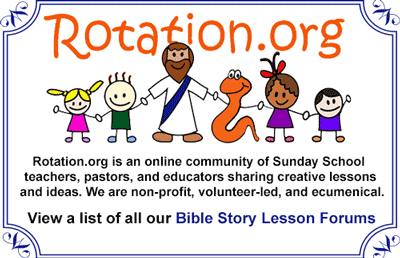
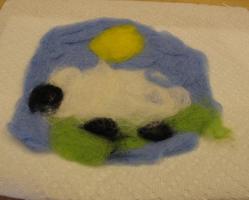 Squeeze out excess water by rolling felt picture in a towel.
Squeeze out excess water by rolling felt picture in a towel.
